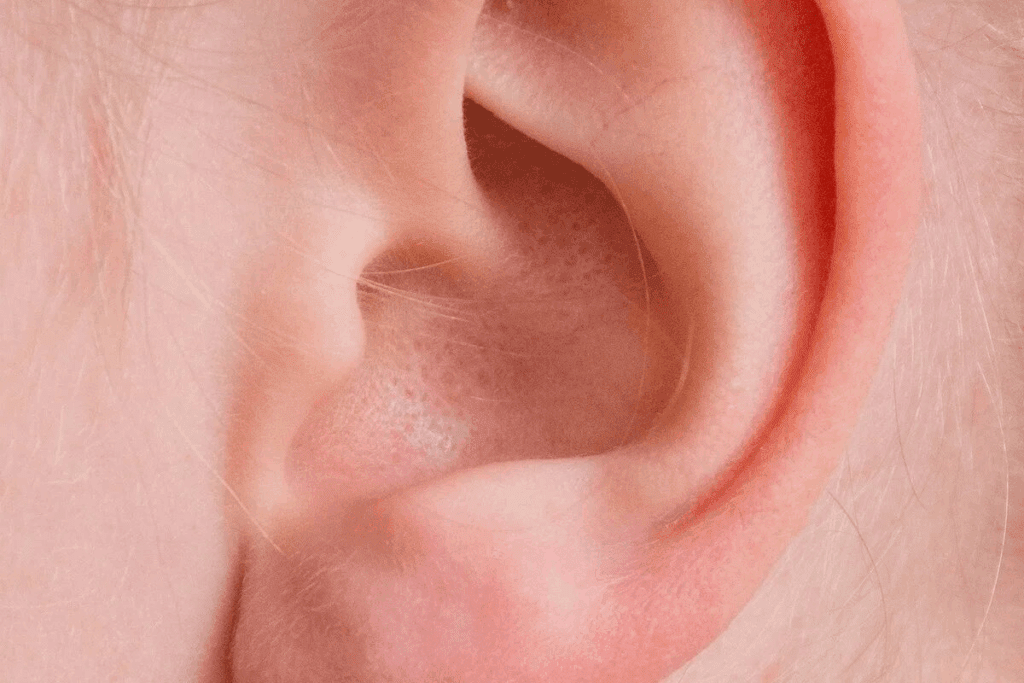
Can ear infections spread? Learn the difference between contagious upper respiratory infections that cause ear infections and non-contagious middle ear fluid itself.
Ear infections are a common worry, often for parents. Many ask if these infections spread. The truth depends on the infection’s cause.
Ear infections are not contagious in the usual way. But, the viruses or bacteria that cause them can spread easily. Medical Expert, an expert in ear health, says, “The upper respiratory infection is likely contagious. But, whether it moves to the ears is another matter.”
At Liv Hospital, we stress knowing the difference. This helps us give the right care and info. We aim to offer top-notch healthcare and support for patients from abroad.

Ear infections are a common health issue that affects people of all ages, but they’re more common among children. We will explore the different aspects of ear infections to better understand their causes and effects.
There are several types of ear infections, each affecting different parts of the ear. The most common type is acute otitis media, which affects the middle ear. This condition is most frequently seen in children between six months and two years of age. Other types include otitis externa, also known as swimmer’s ear, which affects the outer ear canal.
Ear infections are a significant health concern, mainly in pediatric care. According to Medical Expert, “Children are simply more prone to these infections because their immune system is less developed and they are exposed to more viruses in daycare and school.” Statistics show that ear infections are among the most common reasons for doctor visits in children, highlighting their prevalence and the need for awareness.
Understanding the prevalence of ear infections can help us identify risk factors and take preventive measures. By recognizing the types of ear infections and their commonality, we can better manage and treat these conditions.

When many family members or classmates get ear infections at the same time, it makes people wonder if they can spread. Ear infections aren’t directly contagious. But, the germs that cause them often come from colds or flu, which are contagious. We’ll look into why ear infections seem to happen together.
Ear infections themselves can’t be caught from someone else. But, the germs that cause many ear infections come from colds or flu. Medical Expert, “The bacterial or viral upper respiratory infection that leads to the otitis media is contagious, though.” This means you can’t directly get an ear infection from someone else. But, you can catch a cold or flu that might turn into an ear infection.
Ear infections seem to happen together because of shared germs. When family members or classmates are close, they’re more likely to pass on germs. Here’s why:
Knowing these reasons can help prevent infections that might lead to ear infections.
Ear infections can be very painful and disrupt our lives. But, it’s not always clear how they start or how they’re linked to other illnesses. Looking at the bigger picture helps us understand this connection.
Upper respiratory infections, like the common cold and flu, spread easily. They can move through the air when someone coughs or sneezes. These infections can lead to ear problems because they affect the Eustachian tube.
When we have a cold or flu, the Eustachian tube can become swollen or blocked. This blockage causes fluid to build up in the middle ear. This creates a perfect place for bacteria or viruses to cause an infection.
Medical Expert, “The Eustachian tube connects the middle ear to the back of the throat. It can become swollen or blocked when you have a cold or allergies.” This tube is key for air pressure in the ears to match the environment. It’s important for the eardrum to vibrate properly.
When the Eustachian tube works right, it drains mucus from the middle ear. But, if it’s blocked or not working, it can cause ear infections. Understanding this connection is key to preventing and managing ear infections.
By knowing the link between respiratory infections and ear problems, we can lower the risk of ear infections. We can practice good hygiene, like washing our hands often, and avoid close contact with sick people.
Ear infections can come from many sources. This includes bacteria and viruses, as well as our environment and body shape. Knowing what causes them helps us find ways to prevent and treat them.
Bacteria often cause ear infections, mainly in kids. Streptococcus pneumoniae, Haemophilus influenzae, and Moraxella catarrhalis are the top culprits. They make the middle ear inflamed and fill it with fluid.
“Children have poorly developed Eustachian tubes, which provide air to the enclosed middle ear space. Inflammation of the Eustachian tube prevents aeration and fluid drainage from the middle ear space,” notes Medical Expert.
The Eustachian tube is key to keeping the middle ear healthy. It helps with air pressure and mucus drainage. If it’s blocked or not working right, bacteria can grow and cause infection.
Viruses also cause ear infections. Respiratory viruses like RSV, influenza, and adenovirus can lead to ear infections. These usually happen when someone has a cold or other respiratory infection.
There’s a strong link between viral infections and ear infections. When a virus inflames the Eustachian tube, it can cause fluid to build up in the middle ear. This makes it easy for bacteria to grow.
Our environment and body shape also affect ear infections. For example, being around secondhand smoke, going to daycare, and having allergies can raise the risk.
Risk Factor | Description |
Secondhand Smoke Exposure | Increases the risk of ear infections by irritating the Eustachian tube and promoting bacterial growth. |
Daycare Attendance | Higher exposure to viral and bacterial pathogens in daycare settings can increase the risk of ear infections. |
Allergies | Allergic reactions can cause Eustachian tube dysfunction, leading to fluid buildup and infection. |
Body shape issues, like a deviated septum or big adenoids, can also cause ear infections. They can block the Eustachian tube.
By understanding ear infection causes, we can better prevent and manage them. This includes knowing about bacterial and viral infections, as well as environmental and body shape factors.
Age affects how likely someone is to get an ear infection. Babies, kids, and adults face different challenges. Each group has its own health concerns related to ear infections.
Medical Expert, “Adults can get ear infections, but it’s rare.” This shows ear infections are more common in some ages than others. We’ll look at how they affect babies, kids, and adults, highlighting their unique issues.
Babies are at high risk for ear infections because their immune systems are not fully developed. Their Eustachian tubes are shorter and more horizontal, making it easier for bacteria to get into the middle ear. Ear infections in babies can be a sign of an underlying issue that needs prompt medical attention.
Babies with ear infections might seem irritable, have a fever, or have trouble feeding. It’s important for parents to watch for these signs and get medical help if they think their baby has an ear infection. Early diagnosis and treatment can significantly reduce the risk of complications.
As kids get older, ear infections might happen less often. But they can happen. The symptoms in older children can include ear pain, hearing difficulties, and fever. These symptoms can make it hard for them to do their schoolwork or play.
Parents and caregivers should know these symptoms and get medical help. Sometimes, kids with many ear infections might need special treatments like tympanostomy tubes.
Ear infections can happen in adults, though it’s not as common. The reasons and symptoms can be different from those in kids. Adults might feel ear pain, have trouble hearing, or get tinnitus. Underlying conditions such as allergies, colds, or sinus infections can contribute to the development of ear infections in adults.
“Adults can also catch URIs and get middle ear infections, but it is much less common,” notes Medical Expert. This highlights the importance of considering other possible causes of ear symptoms in adults, such as Eustachian tube dysfunction or other health issues.
It’s key to understand how ear infections show up differently in various age groups. By knowing the unique signs of ear infections in babies, kids, and adults, we can better treat and prevent them.
It’s important to know the signs of ear infections to get help quickly. Ear infections can make you feel very uncomfortable and affect your daily life.
Ear infections show several common signs. These include:
The symptoms can change based on the type and how bad the infection is. For example, a middle ear infection might hurt more and cause fever. An outer ear infection might itch and look red.
Knowing when to see a doctor for ear infection symptoms is key. Medical Expert, “See your doctor if symptoms last more than a few days, get worse, or cause a lot of pain or fever.”
If you or your child have any of these, get medical help:
Symptom | Severity | Action |
Mild ear pain | Mild | Monitor; consider over-the-counter pain relievers |
Severe ear pain | Severe | Seek medical attention |
Fever | High | Seek medical attention if persistent or very high |
Diagnosing and treating ear infections needs a detailed plan. This plan looks at the infection’s type and how serious it is. Ear infections can really affect someone’s life, so quick and effective treatment is key.
Doctors use a mix of physical checks and sometimes extra tests to find ear infections. Healthcare professionals often look into the ear with an otoscope. They look for signs like redness, swelling, or fluid.
More tests might be needed to find the infection’s cause or to check hearing. These tests include tympanometry and acoustic reflectometry. They check the eardrum’s movement and middle ear fluid.
Treating ear infections can involve several steps. For bacterial infections, antibiotics are often given. But Medical Expert, “Many ear infections get better on their own, so waiting before antibiotics is often recommended.” This helps avoid antibiotic misuse and resistance.
For pain, over-the-counter medicines like acetaminophen or ibuprofen are suggested. If the infection is severe or lasts long, more treatments might be needed. This could include tympanostomy tubes to drain the middle ear.
There are also home remedies to ease ear infection pain. A warm compress on the ear can help. Sleeping with the head up can also help by reducing ear congestion.
Good hygiene is also important. Avoid putting things in your ear canal to prevent damage. Using medical treatments and these home remedies can help manage symptoms and aid in recovery.
To prevent ear infections, we need to take a few steps. Good hygiene, a healthy lifestyle, and keeping up with vaccinations are key. These actions help lower the chance of getting ear infections and keep our ears healthy.
Keeping clean is vital in stopping infections that can harm our ears. Medical Expert, wearing masks when needed, and blowing your nose often. This helps stop viruses and bacteria that cause ear infections.
Also, avoid touching sick people, don’t share things like utensils or towels, and clean often-touched surfaces. These steps help prevent the spread of germs.
Choosing a healthy lifestyle is important too. Stay away from smoke, eat lots of fruits, veggies, and whole grains, and exercise regularly. Breastfeeding for at least six months also strengthens a baby’s immune system, lowering ear infection risk.
Try to avoid allergens and pollutants like dust and air pollution. This can also help prevent ear infections.
Vaccines are a great way to prevent infections that can lead to ear problems. Make sure to get the pneumococcal conjugate vaccine (PCV) and the flu vaccine. These shots protect against infections that can cause ear infections.
Here’s a table with important vaccination info:
Vaccination | Age Group | Benefit |
Pneumococcal Conjugate Vaccine (PCV) | Children under 2 years | Protects against pneumococcal disease, which can cause ear infections |
Influenza Vaccine | 6 months and older | Protects against flu, which can lead to ear infections |
By following these tips on hygiene, lifestyle, and vaccinations, we can greatly reduce ear infection risk. This helps keep our ears healthy.
Understanding ear infections helps us manage and prevent them. Ear infections often come from respiratory infections. The Eustachian tube is key in ear problems.
Medical Expert. Good hygiene, a healthy lifestyle, and vaccines are important. These steps lower ear infection risks.
We can control our ear health by knowing the risks and taking steps to prevent them. This way, we can lessen ear infections and get timely treatment.
To manage ear infections well, we need to know the causes and prevent them. By using these strategies, we can lessen ear infections’ impact on our lives.
Ear infections themselves are not contagious. But, the causes like bacteria or viruses can spread from person to person.
No, you can’t catch ear infections from touching someone who has them. But, if the cause is something contagious like a cold, it can spread.
Otitis media, or middle ear infections, aren’t contagious. But, things like Eustachian tube problems or colds can lead to them.
Ear infections can happen together because of common causes. This includes viruses or bacteria, or things like allergens in the air.
No, you can’t directly give someone an ear infection. But, if it’s caused by something contagious, it can spread.
Ear infections aren’t spread directly. Instead, the causes like viruses or bacteria can spread through droplets in the air or touching things that are contaminated.
Middle ear infections, or otitis media, aren’t contagious. But, things like Eustachian tube problems or colds can cause them.
An earache is a symptom, not something you can catch. But, if it’s caused by something contagious, it can spread.
Double ear infections, or bilateral otitis media, aren’t contagious. But, causes like Eustachian tube problems or colds can lead to them.
Ear infections aren’t contagious, no matter the age. But, babies might get them more easily because of their anatomy and developing immune systems.
National Center for Biotechnology Information. (2025). Are Ear Infections Contagious What You Need to. Retrieved from https://www.ncbi.nlm.nih.gov/pmc/articles/PMC2786955/
Subscribe to our e-newsletter to stay informed about the latest innovations in the world of health and exclusive offers!
WhatsApp us